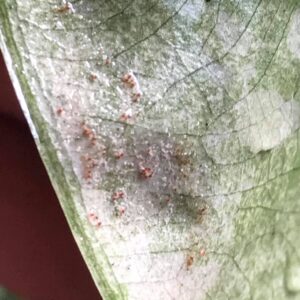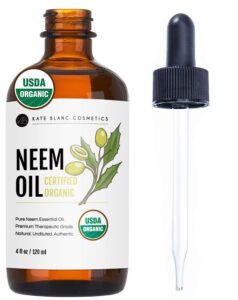Semi-hydroponic systems, popular for indoor gardening with mediums like LECA or Pon, are not immune to pest challenges, notably spider mites.
These tiny pests can significantly damage houseplants by feeding on their sap and reproducing rapidly. Identifying, treating, and preventing spider mite infestations are crucial for maintaining the health of your semi-hydroponic plants.
This guide offers effective strategies for managing these pests, from early detection to natural and chemical control methods, ensuring your houseplants remain vibrant and healthy.

What are Spider mites?
Spider mites are not true spiders but are closely related, a common adversary in the gardening world.
Measuring about a millimeter, these pests can be various colors, often red or green.
In semi-hydroponic systems, such as those utilizing Lightweight Expanded Clay Aggregate (LECA) or Pon, these mites are particularly notorious for attacking the underside of leaves, forming dense colonies.
The first sign of their presence is often the fine, silky webs they spin, which can be extensive in severe infestations.
These mites thrive in warm, dry environments, making indoor gardens a perfect habitat.
In semi-hydroponics, where plants are nurtured in a soilless medium, spider mites can go undetected due to the lack of soil disturbance, making regular inspection a critical practice for plant health.
In optimal conditions, such as a hot and dry environment, these pests can astonishingly complete their lifecycle – from egg to adult and then producing more eggs – in just three days. This rapid life cycle not only enables them to suddenly infest plants but also contributes to their ability to quickly develop resistance to treatments.
Ineffective attempts to eliminate these mites often result in inadvertently breeding a resilient, ‘super’ variant that is resistant to previous treatment methods.
Spider Mites on Semi-Hydroponic Houseplants
Spider mites are more than just a nuisance; they pose a significant threat to the health of houseplants. These tiny pests pierce plant cells to feed on sap, which leads to a variety of symptoms, including stippling, yellowing, and eventual leaf drop.
The damage often starts subtly but can escalate rapidly as the mite population grows.

In a semi-hydroponic setup, where plants rely on a balance of nutrients and water in an inorganic medium, the stress caused by spider mites can be even more detrimental.
The mites not only physically damage the plant but also make it more susceptible to other stressors, including nutrient imbalances and environmental fluctuations.
How to know If my plants got affected by Spider-mites
The earliest indication of spider mite damage is the presence of fine stippling on leaves, resembling numerous tiny holes as if pricked by a needle. This damage is commonly concentrated around the leaf veins, particularly the central vein. In cases of severe damage, leaves may appear whitish or greyish.
Advanced infestations are characterized by visible webbing, especially on the undersides of leaves and around new growth areas.
Unlike the structured webs of many spiders, spider mite webbing is irregular and chaotic.
In advanced stages, the mites can be seen moving along these webs.
How to Deal with Spider Mites on Semi-Hydroponics
Being true arachnids, spider mites are generally immune to most insecticides. The most effective control methods involve using pesticides specifically designed for them.
For mild infestations, non-pesticide alternatives might suffice if applied early.
However, for established infestations, the use of targeted miticides is essential to effectively combat these resilient pests.
1. Remove Infested Plants or Parts
Early detection is crucial. In mild cases, simply removing and discarding the affected leaves or entire plants can prevent the mites from spreading.
Be sure to dispose of these parts responsibly to avoid contaminating other areas.
2. Soapy Spray Treatment
A gentle yet effective method involves using a soapy water solution.
Mix a teaspoon of mild liquid soap with a quart of water. Spray this mixture directly onto the affected areas of the plant, focusing on the undersides of leaves where mites congregate.
Repeat this treatment every few days until the infestation is under control.
3. Non-Pesticide Controls:
- Horticultural Oil/Dormant Oil: This oil acts as a mechanical pesticide, suffocating mites without allowing resistance development. It’s most effective when applied regularly, several days apart, as it targets mobile mites but not their eggs. It can enhance the effectiveness of other pesticides but only works on direct contact and doesn’t leave a residue.
Caution: High temperatures (above 80-85°F) or sensitive leaves can lead to damage. Always conduct a spot test before full application. - Soapy Water & Peroxide Solution: Use a mixture of genuine soap (like Dr. Bronner’s or safer insecticidal soap) with 3-4 tablespoons of 3% hydrogen peroxide per cup of water. Apply the mixture and gently wipe the mites off with a soft, damp cloth. Rinse with plain water afterward. This method is effective only on direct contact and does not provide residual effects.
4. Miticides:
- Avid (Abamectin): A popular miticide, Avid effectively controls mites, leaf miners, and partially suppresses aphids, thrips, and whiteflies. It impacts larvae, nymphs, and adults but doesn’t affect eggs. Avid is translaminar, meaning it penetrates and acts within leaf tissues. It’s semi-systemic within the leaf but not the entire plant.
- Forbid (Spiromesifen): This newer miticide and ovacide combats resistant mites, targeting eggs, larvae, and nymphs, but not adults. Like Avid, it’s both contact and translaminar, offering protection for 30-45 days. It’s priced at around $220-$240 for an 8oz bottle.
- Floramite SC (Bifenazate): Effective against a broad spectrum of mites, Floramite provides quick knockdown and 28 days of residual control. It’s active on all life stages, from egg to adult, but is a contact-only pesticide. Ensure thorough coverage, especially under leaves. Floramite costs about $85-$120 for an 8oz bottle.
5. Insecticides:
- Bifenthrin: Recommended solely for mites, Bifenthrin can suppress but not fully control spider mites. It’s highly effective when combined with the above miticides and can eliminate most other pests. A 16oz bottle is reasonably priced at $22 and is available here.
5. Neem Oil
This is always known as one of the best organic ways to deal with spider mites.
- Use for Plants: Beneficial for houseplants and indoor plants; can be added to dog shampoo for fur treatment.
- Skin Benefits: Clears blemishes, prevents breakouts, restores moisture, and promotes soft skin; helps calm redness and itchiness.
- Rich Composition: High in essential fatty acids and Vitamin E, ideal for nourishing skin, hair, nails, and dog fur.
Neem oil, derived from the seeds of the neem tree, acts as a natural insecticide. When diluted with water and sprayed on plants, it disrupts the life cycle of spider mites, effectively reducing their population.
As a bonus, neem oil also offers some fungicidal benefits, helping to protect plants from other potential issues.
6. Using Azamax:
In more severe cases, Azamax can be a powerful tool.
It contains azadirachtin, the active component of neem oil, in a more concentrated form. It’s particularly effective when combined with neem oil, offering a dual approach to mite eradication.
When using Azamax, follow the manufacturer’s instructions carefully for mixing and application.
7. Predatory Bugs:
Biological control is another effective strategy.
Introducing predatory insects like Phytoseiulus persimilis (a type of predatory mite) or ladybugs into your semi-hydroponic system can naturally reduce spider mite populations.
- Content: Includes 1500 live ladybugs with guaranteed live delivery.
- Educational Material: Comes with a ladybug educational sheet featuring release tips, rates, fun facts, and FAQs.
- Diet: Ladybugs are predators of various slow-moving insects like Aphids, Moth eggs, Mites, and more.
- Use: Ideal for kids, birthday parties, school projects, and as a natural pest control method.
These beneficial insects feed on spider mites, helping to maintain a balanced ecosystem in your indoor garden.
How to Prevent Spider Mites when using LECA, Pon, and Normal Soil
Prevention is often easier and more effective than treatment.
In semi-hydroponic systems, where plants are grown in a controlled environment, several strategies can be implemented to prevent spider mite infestations:
- Inspect New Additions: Carefully inspect any new plants for signs of spider mites before introducing them into your garden. Using a magnifying glass can help spot these tiny pests.
- Seed Germination and Cloning: Starting plants from seeds or clones from healthy mother plants can reduce the risk of introducing pests.
- Use of Grow Tents: A grow tent creates a physical barrier that helps prevent pests from accessing your plants. It also allows for better environmental control, which can be adjusted to deter spider mites.
- Temperature and Cleanliness: Spider mites prefer warm, dry conditions. Maintaining a cooler temperature (in the upper 60s Fahrenheit) and ensuring adequate humidity can make the environment less hospitable for them. Regularly cleaning and dusting your plants also helps prevent infestations.
Conclusion
Managing spider mites in semi-hydroponic houseplant systems requires a combination of vigilance, preventive measures





